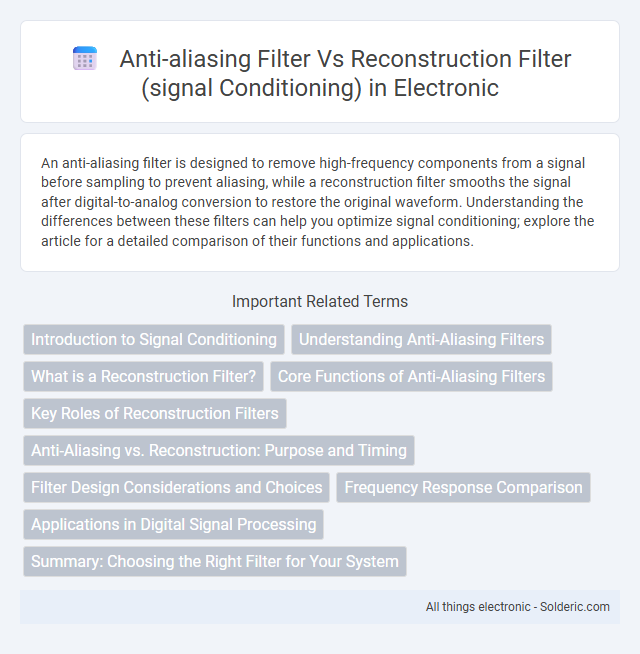An anti-aliasing filter is designed to remove high-frequency components from a signal before sampling to prevent aliasing, while a reconstruction filter smooths the signal after digital-to-analog conversion to restore the original waveform. Understanding the differences between these filters can help you optimize signal conditioning; explore the article for a detailed comparison of their functions and applications.
Comparison Table
| Feature | Anti-Aliasing Filter | Reconstruction Filter |
|---|---|---|
| Purpose | Prevents aliasing by removing high frequencies before sampling | Smooths the signal by removing high-frequency components after digital-to-analog conversion |
| Position in Signal Chain | Before Analog-to-Digital Converter (ADC) | After Digital-to-Analog Converter (DAC) |
| Filter Type | Low-pass analog filter | Low-pass analog filter |
| Primary Effect | Suppresses frequencies above Nyquist frequency to avoid aliasing | Removes stair-step artifacts to reconstruct smooth analog signal |
| Frequency Range | Passes up to Nyquist frequency (half sampling rate) | Passes baseband signals, attenuates images above baseband |
| Typical Implementations | Butterworth, Chebyshev low-pass filters | Butterworth low-pass, smoothing filters |
| Impact on Signal Quality | Prevents aliasing artifacts that degrade signal | Improves signal smoothness and fidelity after conversion |
| Critical Parameter | Cutoff frequency near Nyquist frequency | Cutoff frequency aligned with signal bandwidth |
Introduction to Signal Conditioning
Anti-aliasing filters prevent high-frequency signals from causing distortion during analog-to-digital conversion by removing frequencies above the Nyquist limit. Reconstruction filters, used in digital-to-analog conversion, smooth out the stepped output by eliminating high-frequency components introduced by the sampling process. Your signal conditioning setup benefits from understanding these filters to ensure accurate signal representation and minimize errors during conversion.
Understanding Anti-Aliasing Filters
Anti-aliasing filters prevent high-frequency signals from folding into lower frequencies during analog-to-digital conversion by attenuating frequencies above the Nyquist rate. Reconstruction filters, applied in digital-to-analog conversion, smooth the output signal by removing spectral images and restoring the continuous waveform. Effective signal conditioning relies on precise design of anti-aliasing filters to ensure accurate sampling and prevent distortion in reconstructed signals.
What is a Reconstruction Filter?
A reconstruction filter is a low-pass filter used in digital-to-analog conversion to smooth out the stepped waveform produced by the digital signal, eliminating high-frequency components called images. Unlike an anti-aliasing filter, which prevents aliasing by limiting the input signal bandwidth prior to sampling, the reconstruction filter conditions the output to restore the original continuous-time signal. Your device relies on this filter to ensure accurate and natural analog signal reproduction.
Core Functions of Anti-Aliasing Filters
Anti-aliasing filters primarily serve to remove high-frequency components from analog signals before sampling, preventing aliasing artifacts that distort digital representations. These filters ensure signal integrity by attenuating frequencies above half the sampling rate, known as the Nyquist frequency. Your accurate signal acquisition depends on the precise operation of anti-aliasing filters to maintain faithful digital conversion.
Key Roles of Reconstruction Filters
Reconstruction filters play a crucial role in converting discrete-time signals back into continuous-time signals by smoothing out the staircase effect caused by zero-order hold devices. They effectively remove high-frequency components and quantization noise introduced during sampling to restore the original analog waveform. Unlike anti-aliasing filters that prevent aliasing before sampling, reconstruction filters ensure signal integrity during playback or digital-to-analog conversion by suppressing unwanted spectral replicas.
Anti-Aliasing vs. Reconstruction: Purpose and Timing
Anti-aliasing filters prevent high-frequency signals above the Nyquist frequency from entering an analog-to-digital converter, protecting your digital signal from distortion during sampling. Reconstruction filters operate after digital-to-analog conversion, smoothing the stepped output to recover the original continuous signal by removing high-frequency sampling artifacts. Understanding the distinct roles and timing of anti-aliasing and reconstruction filters is crucial for accurate signal conditioning and maintaining signal integrity.
Filter Design Considerations and Choices
Anti-aliasing filters require low-pass characteristics with steep roll-off to prevent high-frequency components from folding into the baseband during sampling, emphasizing linear phase response to preserve signal integrity. Reconstruction filters prioritize smooth interpolation and minimal distortion in the analog output, favoring designs like Butterworth or Bessel filters for flat passband or linear phase characteristics, respectively. Both filters must balance filter order, transition bandwidth, and implementation complexity while considering the sampling rate and the specific application's tolerance for signal distortion and latency.
Frequency Response Comparison
Anti-aliasing filters exhibit steep roll-off characteristics designed to attenuate frequencies above the Nyquist frequency, preventing aliasing artifacts during analog-to-digital conversion. Reconstruction filters, typically low-pass filters with smoother roll-off, aim to remove high-frequency components and smooth the stepped output of digital-to-analog converters, restoring the original signal waveform. The frequency response of anti-aliasing filters prioritizes sharp cutoff to block unwanted frequencies, while reconstruction filters focus on minimizing phase distortion and achieving a flat passband to preserve signal fidelity.
Applications in Digital Signal Processing
Anti-aliasing filters are fundamental in Digital Signal Processing (DSP) to prevent high-frequency components from causing aliasing during analog-to-digital conversion, ensuring signal integrity by removing frequencies above the Nyquist rate. Reconstruction filters, applied after digital-to-analog conversion, smooth the stepped output by removing high-frequency quantization noise, restoring the continuous signal waveform. Both filters are critical in applications such as audio processing, telecommunications, and instrumentation where accurate signal representation is essential.
Summary: Choosing the Right Filter for Your System
Selecting the appropriate filter hinges on the application: anti-aliasing filters prevent high-frequency components from causing distortions during analog-to-digital conversion by limiting bandwidth before sampling, while reconstruction filters smooth the output of digital-to-analog converters by removing high-frequency artifacts and restoring continuous signals. Key parameters include filter type (e.g., Butterworth, Chebyshev), cutoff frequency, and phase response, which influence system performance and signal integrity. Optimizing filter design based on sampling rate, signal bandwidth, and system requirements ensures accurate signal conditioning and enhances overall fidelity.
anti-aliasing filter vs reconstruction filter (signal conditioning) Infographic

 solderic.com
solderic.com